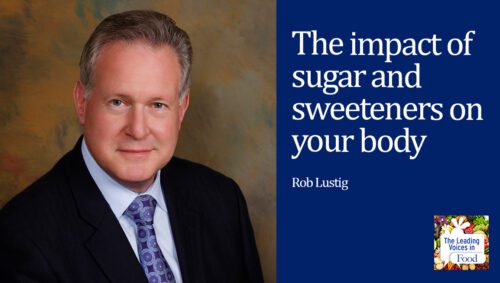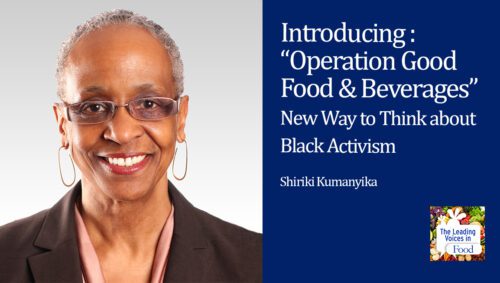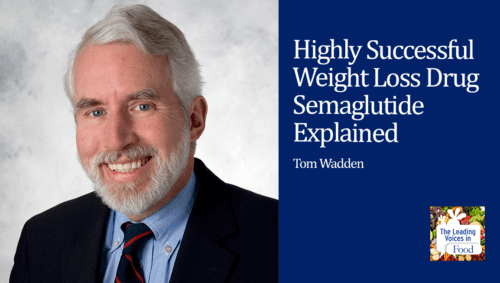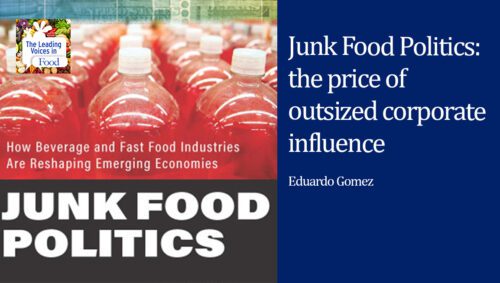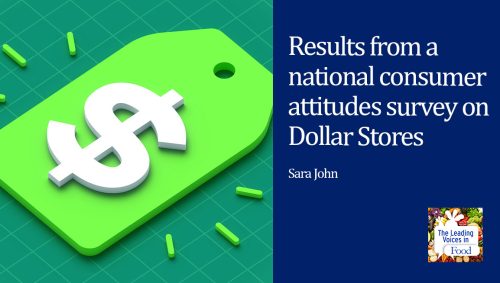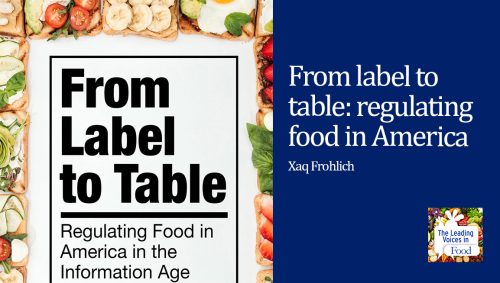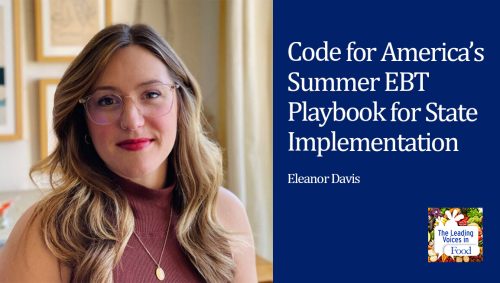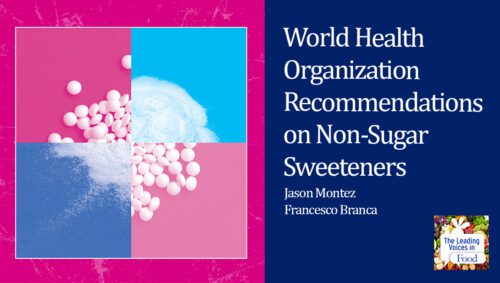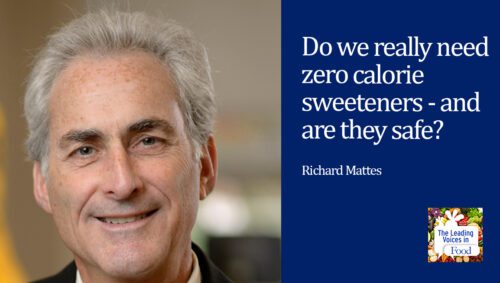The Leading Voices in Food
E16: Sara Bleich on Menu Labeling, Marketing and Public Health
Do you make better food choices when you see calorie counts listed on restaurant menus? Do you think food stamp recipients should be able to buy unhealthy foods, like sugary drinks? And what role should the government play in our food choices? We’ll explore these questions on The Leading Voices in Food with Dr. Sara Bleich.
Subscribe: Apple Podcasts | TuneIN | Google Podcasts | SoundCloud | PocketCasts | Radio Public
Tags: Addiction & Food | Advocacy & Food | Food Industry Behavior & Marketing | Food Policy | Food, Psychology & Neuroscience | Obesity |

Sara Bleich is professor of public health policy at the Harvard Chan School of public health. She is also the Carol K. Pforzheimer Professor at the Radcliffe Institute for Advanced Study. Her research provides an evidence base to support policies to prevent obesity and other related diseases, particularly among vulnerable populations. The signature theme that we’ve seen through her work as an interest in asking simple, meaningful questions which can fill important knowledge gaps. Her work has been published in the top journals in the field such as the New England Journal of Medicine, the British Medical Journal, Health Affairs, and American Journal of Public Health, but has also been featured for the public and outlets such as New York Times The Washington Post, Wall Street Journal, and National Public Radio. Sara’s received numerous awards including one for excellence in public interest communication. From 2015 to 2016. She served as a White House fellow where she worked as a senior policy advisor to the US Department of Agriculture and also to the First Lady’s Let’s Move Initiative.
Interview Summary
To begin with a discussion of Federal menu labeling of legislation: after many delays, the Federal menu labeling rule was implemented this past May. Would you explain what the legislation is all about? Is the beginning.
Sure, so included in the Affordable Care Act, which passed in 2010, which is also known as Obamacare, there was this little provision which had bubbled up from the local level and required that large chain restaurants are required to post calories alongside price. This first started in New York City and then by the time it got to the Federal level, more than 20 cities or localities around the country had adopted some version of this. And so the Federal role was an attempt to make a uniform rule that applied to chain restaurants around the country. And then one thing that happened is that the role was expanded to not just apply to chain restaurants, but to also think about how people eat today. So it includes entertainment venues and ice cream shops and movie theaters. And all those places, as of May 2018 when the rule was implemented, are required to post calories alongside price.
The legislation was passed in 2010 and now we’re in 2018, why in the world did it take so long?
Yeah. Well, there, there are a number of reasons why it sort of got kicked down the road. It was delayed by both the Obama Administration and the Trump administration and a lot of the delays related to key push back from different industry groups. So for example, one industry group that was really opposed to the legislation was the pizza lobby. They felt like it was burdensome to have to apply calories to all the different variations that you could make for a pizza. And another key group that opposed the legislation where the grocery stores, the small grocery lobby. But in the end, you know, this rule was backed by a large chain restaurants because for them it was very, very challenging to have one set of rules in one city and other set of rules in another city. And so yes, it did take eight years for the rule to get implemented, but now it is, and should be available all around the country.
What impact do you think this will have on the population’s health?
Well, the original thought behind menu labeling was you put calories alongside price and that provides transparency to consumers and helps them make better choices at the point of purchase. And since the law was implemented or passed in 2010 there have been lots and lots of opportunities to study the effect of menu labeling on consumer behavior. Because there have been all these local policies that have passed and the takeaway from more than 55 or 60 studies focused on consumer behavior is that menu labeling appears to have little to no impact on what consumers are doing at the point of purchase. The exception is maybe in certain venues like cafes or in coffee shops. Consumers do tend to purchase a little bit fewer calories, but what the evidence instead suggests is that the story of menu labeling is not that consumers are changing their behavior, but the story of menu labeling is that restaurants are changing their offerings in response to the transparency that menu labeling demands. And so we’ve done a lot of work over the past several years tracking the largest chain restaurants around the country. So these are the largest revenue generating restaurants. Your McDonalds, your Chipotles your Cheesecake Factories and so on. And what we find is that if you compare items that are newly introduced year over year, we find that the calories and newly introduced menu items are going down over time by about 60 calories or 12 percent. And interestingly that the highest calorie items appear to be dropping off the menu.
Very impressive change. So there are many things that could be responsible for that in addition to menu labeling, is it possible to define the impact of menu labeling per se?
It’s not. And you know, one of the things that’s interesting is the trend data that we have is available starting in 2012 and obviously the Federal Menu Labeling rule started in 2010. And so ideally we would have data before and after, so we can answer that exact question to what extent are the observed changes in restaurants are attributable to menu labeling versus something else. It very well could be part of a larger secular trend. We have done work looking at restaurants who voluntarily said even in the absence of the Federal rule being implemented, we’re going to go ahead and post calories. So McDonalds is an example of one restaurant that did that and when you compare restaurants that voluntarily posted labels to those that did not, what you find is that that average calories among those with voluntary labeling was lower. So there does appear to be some sort of trend that’s happening that may be above and beyond menu labeling.
And from my perspective, you know, the why it’s happening for a population health perspective is less important than the impact that it could potentially have. And so on a typical day, a third of kids and a third of adults eat at chain restaurants, particularly fast food restaurants. And the beauty of these supply side changes that we’re observing is that unlike the consumer side, which demands that you see the calories and that you change your behavior and response, changes that are happening on the menu are largely invisible to consumers and they’re not requiring individuals to change their behavior–which is very resistant to change. And because we’re seeing calories being pulled off of menus and it doesn’t take a lot of extra daily calories to drive obesity, the potential impact of this cycle, of this change of restaurant behavior could have a positive impact on population health.
You have a fascinating perspective on this. I’d like to ask a particular question about the history. So before I came to Duke, I was at Yale University for a number of years with our group at Yale was working to some extent with the New York City Department of Health when they passed the first set of regulations around menu labeling. And one of the things that I thought was historic about it, there were the impacts on the restaurant behavior, consumer behavior that you’ve just now addressed, but it also seemed to me it was historic because it was the first time to my awareness that a city department of Health had express jurisdiction over the long-term consequences of food. The short term consequences of food, you know, people getting sick from tainted us in a diner there, they are all over and they, the cities have expressed long-term interest in educating people about the long-term consequences of food, but had never, to my knowledge, gotten in and done anything in a regulatory way about this. And it was interesting in that New York City said we have jurisdiction here and it’s in our legal purview to do something about diabetes, heart disease, and the other things they could follow from a lifetime of eating some of these unhealthy foods. Does it, do you. Do you think that’s true that that was in a historic breakthrough when the menu labeling legislation you’ve got introduced?
I do think it was a historic breakthrough and I think it was an example that was then followed by several other cities that also adopted that same legislation and you know, New York and a lot of ways has been on the vanguard of progressive obesity policies. So an example where New York attempted to establish jurisdiction but was unable to, was the portion cap role where they tried to pass a law saying that anything larger than a 16 ounce size beverage could not be served within New York City limits. And that was passed but then overturned based on the claim that New York City didn’t have jurisdiction. So I think it’s something which has been tested and pushed by health departments, but I do think it was historic when it comes to menu labeling and I suspect for, for leading health departments like New York, like Philadelphia, or probably see more of this in the future.
We had Shiriki Kumanyika come and do a podcast with us, which was terrific and she explained a lot about disparities by race and income. And I know you worked on that as well. What are you think are some of the interesting policy solutions to disparities?
Yeah, well I’m so glad that you had Shiriki on the podcast because she obviously is a leading thinker in this area. My thought around health disparities, which certainly when it comes to obesity and lots of diet related diseases, they’re very persistent. So if you look over time, there are these very longstanding, for example, black/white gaps in the prevalence of obesity where you have higher rates among black Americans and white Americans. Similarly by income, higher rates of obesity and diet related conditions among low income versus high income populations. And I think where a lot of the policy opportunities lie is looking outside of specifically health and thinking more broadly about the social determinants of health. And so that refers to things like where a person is born, where a person grows up, where they live, where they work. And there’s all sorts of things about those factors, which if they were modified, they could actually have a meaningful impact on disparities. So, for example, if you know that for a lot of people the biggest barrier to getting healthy food is a reliable source of transportation, then the way to get better access to healthy food is then to fix that transportation problem. Similarly, if you know that based on if someone has unreliable housing and because they have unreliable housing, they don’t have a place that they can even store food and say a fridge or other places. Then thinking about how you actually help people find long-term housing that is stable. And so I think that, you know, to really address some of these longstanding disparities, we have to look outside of health and think about the broader factors that shape the way that a person lives, and those would include trying to address maybe income, maybe education, maybe job status, maybe housing, maybe transportation and lots of other factors which are strongly contributing to why we see these huge black white differences and, and along other race and ethnicity lines. And the challenge obviously is none of that is very easy to do, but I think what it requires this republic health to look, you know, outside of the usual partners and look to other parts of the, the city infrastructure and the state infrastructure and think about how can we join forces and by and doing so sort of promote health and reduce disparities at the same time.
This sure argues as well for coordination between agencies at all levels of government. And I’m wondering when in your time as a White House fellow, whether you saw any examples of agencies cooperating on these kinds of issues.
Yeah, so I think one’s experience in government is very dependent on the administration. And so when I was a White House fellow, it was under the Obama administration. It was year seven in an eight year administration. And certainly a really important piece of that administration was interagency collaboration. And the area that I worked in was really around nutrition policy. And what was interesting is that it was probably the first time and more than 50 years that both the East Wing, which is where the first lady sat, since she had the Let’s Move campaign, the West Wing, which is where the president sits and USDA, which is in the executive branch, it’s the Department of Agriculture and overseas nutrition assistance programs, among other things.
There was tremendous alignment around improving nutrition and also around reducing poverty and then that then trickled out to other agencies and, and so for example, transportation was involved and housing was involved. And so I think there was a lot of effort in the last administration, and health and human services, to think about how do we lift families out of poverty and how do we at the same time improve nutrition. Much of that work did take place between the White House in USDA, but certainly it’s the case that there was interagency work trying to facilitate that process.
The Federal government has a great many nutrition assistance programs, as many as 15. What are some of the ways in your mind these programs could be leveraged to better promote health and diet?
That’s right. So under the US Department of Agriculture there are 15 programs. Sort of a suite of nutrition assistance programs. The most widely known is SNAP, which stands for the Supplemental Nutrition Assistance Program. It’s formerly known as food stamps, which is how many people know it. That program alone has a budget of $70 million a year and it helps roughly 40 million, low income Americans (about half of them are children) afford food on a daily basis. And so when you think about SNAP and across the programs, what are some of the things that could be done to improve nutrition among the many, many millions of families that benefit from them. In my mind, one of the key ones is thinking about the role of sugary beverages within these programs. And so stepping back for a second, we know that sugary beverage consumption is very strongly linked to obesity to type two diabetes and a host of other conditions. We know that over time the levels of sugary beverage consumption have been going down over the past decade or so, which is a good thing. But the levels remain unacceptably high among low income and minority populations. And so if you look just at the SNAP program right now, the way that the benefits are administered as you can purchase virtually anything with those benefits. And so one important policy change would be to think about should we restrict the ability of participants to use their snap benefits to purchase sugary beverages because we know of this very strong negative health outcome that’s associated with consuming those drinks. A second is that if you look across all the different Federal nutrition assistance programs, sugary beverages can be currently made available without reimbursement. So one example would be CACFP, which stands for the Child and Adult Care Food program.
So what that means in practice is in a childcare center, sugary beverages can be made available to children, but the programs can’t be reimbursed for them. And so then what are the important policy change would be to prohibit those beverages from being served at all so they can’t be reimbursed and they can’t be served and it is small changes like that, which may sound minor, but essentially it’s modifying the environment. In this case, children, it’s modifying their exposure to sugary beverages, which will hopefully help set their pallets for things that are less sweet when it comes to beverages, so maybe they’ll prefer water if they’re not exposed to sugary beverages so early. And similarly within the SNAP program, the vast majority of participants, 75 percent have income from other sources. And so you could make the argument that they could rely on those resources if they wanted to buy sugary beverages and not use program resources to do so.
This has been a highly controversial policy proposal to government might actually do this.
Yeah, I mean when it comes to nutrition policy, this is like the third rail and you’re exactly right that it’s been so controversial in the sense that there have been a number of states which have requested waivers. So in order for states to have the ability to restrict what someone can and cannot purchase in snap states have to go to USDA and say we’d like permission to be able to do this. And there have been four or five attempts by states and within those states, they’ve tried multiple times and they’ve all been denied. So to answer your question, you know, will this happen in the future? I don’t know. I think that it’s unlikely that it’ll happen in this current administration. I think in the last administration, there was some warming to it towards the end, but it never actually happened. And you know, the reality is that there are a lot of strong arguments on both sides.
So people that oppose this talk about the potential increased stigma for participants, because what it would mean is that when you’re at the point of purchase new UPC codes which define beverages would have to be entered in so that those would be excluded from the basket of things that can be purchased with the SNAP benefit. People that support these policies say yes, it’s possible that stigma can be increased, although unlikely, because it’s so easy to reprogram computers, but the potential benefit in terms of population health far outweighs the potential negatives around stigma. So I think it’s something that’s going to remain front and center right now. The best possibility for a pilot to be conducted would be have to be authorized through the 2018 Farm Bill, which is not going to be going anywhere anytime soon. So I think we sort of are in a wait and see period.
If you could think of a single strategy that might be most effective at addressing the problem of obesity, what would you say?
So recognizing that there is not a single thing which will alone solve their problems with obesity, I would say that if I could wave my magic wand, it would be a sugary beverage taxes. And the reason for that is a couple. One is that sugary beverage taxes have the potential to decrease consumption among everyone because we know that generally people drink sugary beverages quite a bit, but we also know that the consumption is highest among low income and minority populations. So one thing that sugary beverage taxes can do is that they can both reduce consumption and potentially improve health equity, which is really important. The second thing that makes sugary beverage taxes very promising is that they are a very strong nudge and we know that if you change prices, it can really affect behavior. And the empirical evidence on sugary beverages from places like Mexico and from places like Berkeley is that it does appear to reduce consumption and purchases.
Those drinks taxes appear to do so most among low income populations. And because it’s such a strong environmental nudge, it’s less reliant on people sort of thinking very carefully about their behavior and more just respond to these cues in the environment. And I think a third reason why they’re promising is that they have the potential to raise a lot of money for localities that pass them. And so if you look, for example, at Philadelphia, which has a one point five cent per ounce beverage tax that has the potential to generate roughly $90,000,000 a year–and the way that Philadelphia is re-purposing those dollars is in universal Pre-K and green space and other improvements to the city. And so there’s ways to also give those dollars back to populations which are more vulnerable. And my final point is that because of the revenue that’s being generated, it also makes sugary beverage taxes attractive for cities and localities that need extra revenue. And so I’d say for all those reasons, one of the most promising possibilities, although very politically challenging, are sugary beverage taxes.
Another advantage of the sugary beverage taxes is almost everything else that you might think of to address obesity. More treatments, let’s say more education or anything else, costs money. And there’s a question about whether government will actually come up with money to do those things no matter how good the ideas are. And as you mentioned, the sugary beverage tax would not only not cost money but raise money for important causes. So there are, there really are a lot of benefits, aren’t there?
I completely agree. That’s a great point.

